World Records = World Class
The 1990 ZR-1 went 24-hours at 175 mph.
by Hib Halverson
Last Update: 06/09/2010
Image: Morrison Development.
Today, amongst the world's sports cars, Corvette talks the talk and walks the walk. And that was before the 638-hp third-gen ZR1.
Before the last ZR-1 debuted twenty years ago, opinions differed. In the late 1980's, the Vette didn't stack-up well against competitors. Plus, the brand remained tarnished by its late-70s/early-'80s poor performance and quality.
A new platform in 1984, port injection and more power in 1985 and ABS in 1986 helped, but Corvette still lacked a world-class reputation. Chief Engineer, David McLellan, and his development team knew they'd need that if Corvette was to play king of the hill in the high-sports market segment.
March 1989: the 1990 ZR-1 makes a spectacular public debut at the Geneva Auto Show. The combination of C4's already good suspension along with ride-adaptive shocks, a six-speed and the stunning 375-hp, four-cam, 32-valve, LT5 V8, produced world-class ride-and-handing, acceleration and 180-mph top speed. Add Chevrolet's masterful PR/marketing and the ZR-1's impact on Corvette's reputation in the first half of the '90s was huge.
Part of the promotion was the March 1990 "World Record Run" of when a ZR-1 broke three World Land Speed Records, including the 24-hour mark which stood at 160.180 mph for nearly 50 years.
Plans Take Shape
Summer, 1989: one afternoon out in California, PR consultant, Peter Mills, intrigued with the 24-hour record set in July 1940 at Bonneville Salt Flats by Ab Jenkins, was telling professional road racer, Stuart Hayner, about the "24". Mills said that an IMSA GTP team which raced Porsches told him that, amazingly, a 962 (two LeMans wins, '85-'86 World Sports Car and '85-'88 IMSA GTP Championships) lacked the durability to beat Jenkins' 50-year-old mark, the only significant pre-WW2 speed record still standing. Others tried–Ford (1969), Mercedes (1976) and Audi (1988). All failed.
Hayner had recently driven a pre-production ZR-1 in a top speed test for Road&Track: Corvette, an annual R&T published back then, and knew the car's potential, so he suggested the ZR-1. Mills was skeptical until Stu detailed how a bone-stock car went 183 mph on a four-mile course near the California desert town of Yermo.
Stu Hayner and John Heinricy raced Corvettes and Camaros for Tommy Morrison and a few weeks later, in a conversation the two had going to a race at Mosport, Canada, they hatched a plan to break the record. Heinricy, at the time Chevrolet's Corvette/Camaro Product Engineering Manager, was enthusiastic. “Probably the main reason people buy the car is its image, particularly its racing heritage," he said. "I liked to do things to promote its image–the Corvette mystique. World Records are just another reason to want a Corvette."
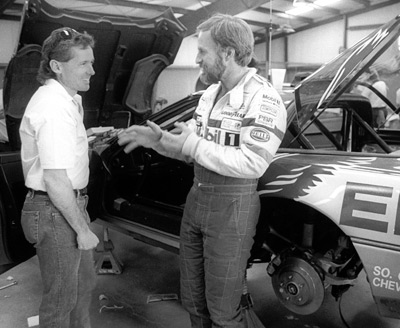
John Heinricy sold the idea to Dave Mclellan who, as John told us, "...was real interested. I don't remember it going higher than McLellan. I think we just decided to do it. It's was the kinda thing that, if you take it higher, somebody's just going to say, 'No.' Then, I talked to Doug Robinson (Development Manager) about a couple of test cars and Jim Minneker (Powertrain Manager) about what powertrain might work."
Tommy Morrison supplied the considerable resources of Morrison Engineering and Development and convinced his racing sponsor, Mobil Oil, to sign on. Hayner's backers, GM’s EDS Division and the Southern California Chevrolet Dealers Association, along with Goodyear, also, joined as major sponsors. For drivers, besides Hayner, Heinricy and Minneker there were: another Morrison regular, Don Knowles; Corvette Engineer Scott Allman; Showroom Stock racers Scott Lagasse and Kim Baker; along with Morrison, himself, making a team of eight.
Few motorsports facilities in North America are suitable for the 24. After considering Daytona and Talladega (too expensive and their high banks loaded the car excessively), a Nissan track in Arizona (Nissan was unwilling) and the five-mile circle at GM's Desert Proving Ground (management had safety concerns), Tommy Morrison selected the Bridgestone Tire Proving Ground at Fort Stockton, Texas, which had a 7.71-mile oval with low-banked, 180° turns and had been the site of Audi's 1988 record attempt. While it could accommodate the speed, 7° banking, no guardrails or lights and an abundance of wildlife (cattle, deer, antelope, javelina and coyotes) in the area made the track dangerous at the 190 mph– a football field every second–they would run.
The Car
Two cars, the ZR-1 and an L98 Coupe used by GM-Europe to set other records, were built and tested during late-'89/early-'90. This included a test at Ft. Stockton in November, 1989.
The Mobil/EDS/SoCal Chevy Dealers/Goodyear ZR-1 had a few performance modifications but many changes to insure reliability/durability and safety. A roll cage and other safety equipment was already in the car from its earlier use as a high-speed development vehicle. A telemetry system replaced the passenger seat so the crew could monitor vehicle parameters in real time. Additional instrumentation and switches for electrical accessories and a 48-gallon fuel cell were installed. FIA rules require “non-consumable” spare parts (brake rotor, radiator hoses, alternator, etc.) be carried in the car, so spares and tools were in a suitcase lashed to the cage’s rear tubes. All this made the car heavy and moved its center of gravity rearward.
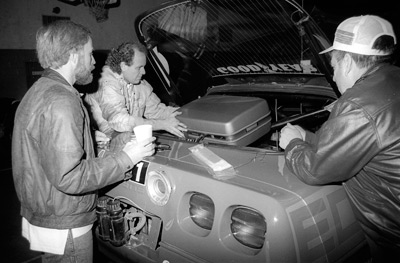
The production suspension had only two major upgrades: 1) unique Goodyear Racing Eagle tires. Goodyear spent $250,000, a incredible sum of money back then, to develop a 17-inch, radial race tire just for the Record Run and 2) removal of the rear antiroll bar to make room for the fuel cell and to optimize the car's handing with altered weight distribution, race tires, 190-mph corner entry speeds and 0.5-g cornering loads.
The exterior was stock except for: no side mirrors, lowered front end and an enlarged, reinforced front air dam fitted with ultrasonic “anti-animal” whistles. Racing lights were installed in fog light and turn signal mounts and two aircraft landing lights went where the front plate normally goes.
"We did everything we could to mitigate risk, "John Heinricy told us. "We calculated the g levels we'd be running. Calculated the tire loads, then gave that to Goodyear and made sure they were comfortable with those loads. They ran tests on the tires. They X-rayed every tire. We had lots of time on that particular car. There was really nothing to break as the car wasn't that stressed. The engine was run hard, but not as hard as we ran them on the dynamometer."
The LT5 was straight from Mercruiser's Stillwater, Oklahoma assembly line. Greg Van Deventer, former member of Stillwater's "LT5 Gang" and who still works there, told us, "That engine was stock. It wasn't shipped because it had a minor balance problem. When the Record Run came up and they were looking for a motor, we gave it to Morrison."
With headers, open exhaust and engine controls calibration revised for racing gasoline, horsepower was 400-410. Tests showed the 190 mph necessary to reset the "24" came at 5500 rpm in fifth, so the gas pedal had a stop at 70% throttle. The car had transmission and rear axle coolers and 3.07 gears replaced the stock 3.54s.
The Run Begins
The group returned to Ft. Stockton in late February. Present were: the drivers; Crew Chief, Tommy Roe and the Morrison Development team; GM engineers and technicians; a Goodyear contingent; sponsor and PR reps and, most importantly; officials of the United States Auto Club which sanctions FIA record attempts in the United States. After a week or so of preparation and a two-day delay for a winter storm, they were ready.
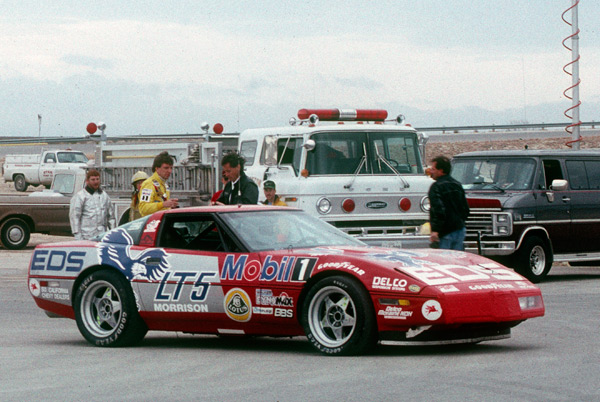
On 1 March, 1990, it was 35°, windy and overcast as John Heinricy rolled onto the TPG oval for a warm-up lap and, the next time by start/finish, at 9:55:12 AM Central Standard Time, USAC's clocks started on Corvette's attempt to reset the 24 Hour World Land Speed Record.
"Depending on wind," Heinricy told us, "speed was in the low 190s. We didn't lift in the turns. We entered them foot on the floor and by the time we came out of it, we'd be in the high-170s. It didn't slow down much in the turns.
"Getting through the first pit stop was important. I felt a lot better when that car left after my stint.”
The Run continued smoothly. About every 80 minutes, the car came in. It took about 45-seconds to a minute to fill the 48-gal. tank, switch drivers, put on new Goodyears and clean the windshield.
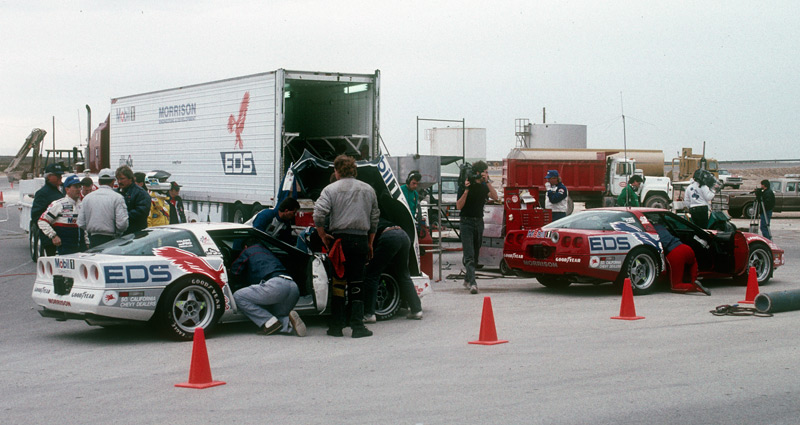 By late afternoon, after eight hours, there was less worry about the car's reliability. The powertrain was running well. The chassis and tires weren't taxed that much by the low cornering loads.
By late afternoon, after eight hours, there was less worry about the car's reliability. The powertrain was running well. The chassis and tires weren't taxed that much by the low cornering loads.
There were weather concerns. Don Knowles, in his afternoon stint, not only had 25-mph wind gusts but ran through intermittent drizzle and snow flurries. Think about that: driving 190-mph in light rain or snow–on race tires...with occasional cross winds.
Other of the Team's fears were things biological rather than mechanical. Hit a cow or a deer at near 200, the result would be instant death. Seven pairs of men, in trucks spaced about a mile apart on the outside of the track, scared off animals with shotgun blasts in the air. The Team never saw a bovine or Bambi, but coyotes were small enough to slip by unseen. While they weigh only 35-40-lbs, hitting one could be catastrophic and it almost happened around sundown.
Hayner was running 180-plus through Turn Four (last half of the north turn) when he saw a chilling sight. "A little speck on the outside edge of the track," Stu recalls. "It was a coyote and I had no chance whatsoever to brake. I decided to hit it and suffer the consequences rather than run off the track at near 200 trying to avoid it. I didn't lift–figuring it wouldn't make any difference. He came 10 or 15 feet down the banking. When I got 100 yards away, he heard the car. He stopped. I missed him by a few inches. This all happened in, like, two seconds."
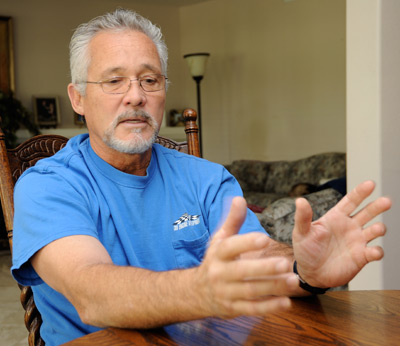 Birds were a danger, too. An encounter with a Corvette at 190 was over quick as you can say "splat." Stu Hayner told us, "I was out of the car and watching. I heard the radio, 'There's a great big bird on the track.' The car was coming and this bird, just–poof! At 200 miles an hour, they vaporize. We went out on the track and couldn't find anything but a few feathers."
Birds were a danger, too. An encounter with a Corvette at 190 was over quick as you can say "splat." Stu Hayner told us, "I was out of the car and watching. I heard the radio, 'There's a great big bird on the track.' The car was coming and this bird, just–poof! At 200 miles an hour, they vaporize. We went out on the track and couldn't find anything but a few feathers."
The real fear was a bird coming through the windshield. Fortunately, the ZR-1's glass was tough. "Usually, you didn't even see the birds, "John Heinricy added. "They'd just go 'Bang!' on the windshield. I hit two or three. Other guys hit them, too. Occasionally, we came in with one stuck in the front end."
Fright Night
There was no moon on March 1st. One evening before the run, Hayner was leaving the track and stopped outside the gate. "That night was as black as if I was in a closet with blankets over my head," he recalls. "If there'd been an animal 30 feet away, you couldn't have seen it."
"The late night stuff was scary." Scott Allman added, "It was so dark, you couldn't see past the edge of the track. We had lights at the entrance and exits of both turns, so when you exited one turn, you could identify the next turn, but, except for the lights on the car, the straights were completely invisible. If some critter ran in front of you, you'd have no warning. We lapped at 190-mph–280 feet-per-second. The field of vision at night allowed less than a tenth of a second visibility before you'd hit an object in your path. I calculated that based on a coyote entering the track perpendicular to the path of the vehicle. Not a comforting thought, since it takes half-a-second just to recognize an event that requires a motor response."
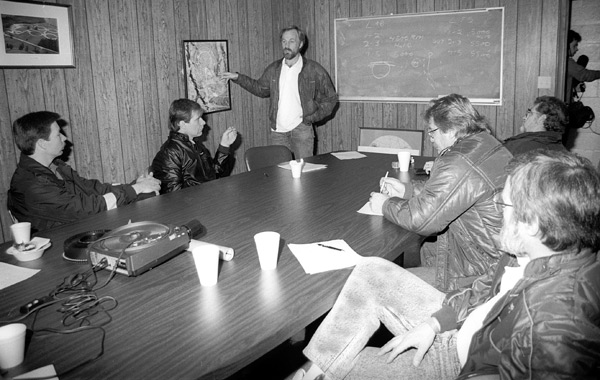 Before the Run, there was a meeting with the fire/rescue squad. "I remember that like it was yesterday," Stu Hayner recalled, "We were thinking it was just another track–another race. Any time I'd been racing, if anything happened, by the time I came to a stop, safety crews were on the way. Somehow, we lost the idea that wasn't possible at Ft. Stockton.
Before the Run, there was a meeting with the fire/rescue squad. "I remember that like it was yesterday," Stu Hayner recalled, "We were thinking it was just another track–another race. Any time I'd been racing, if anything happened, by the time I came to a stop, safety crews were on the way. Somehow, we lost the idea that wasn't possible at Ft. Stockton.
"Heinricy had calculations," Stu continued, "which said, if we went off the outside of a turn, we'd fly such and such a distance (ed: it was 375-ft) before hitting the ground. That was a reality check, too. Then, they talked about big boulders out there along with all the animals. No guardrails? I figured there was less to hit. I was still pretty young, then. I think some of us were thinking: it won't happen to us. That's the mentality of most race drivers."
The Fire Chief was asked how long it would take to get to the car if there was an incident. He replied, "It depends if you're on fire or not." According to Hayner, the Chief's wry humor drove home the idea, "If you weren't on fire, he might not find you until morning–it was that dark–and if you were on fire, it still would be, maybe, 20-minutes because the facility was so big and you'd be on rough ground far from the track."
Thankfully, no one went off the track, but besides the dread of that, there were other nighttime "experiences" which creeped-out drivers. "One thing that sticks in my mind is fog," John Heinricy told us. "Several times that night, I hit fog. It was really scary because the fog was in patches. I'd suddenly see it in the lights and then it would break over the windshield almost instantly. Luckily, it wouldn't last for any length of time. If it had been a big patch of fog, I'd have been in serious trouble."
Through the long night, the LT5 never missed a beat and the rest of the car's systems generally performed well. Lap after lap, lights boring a hole in the dark, the ZR-1 ran 190 down the straights and into the corners and 175-180 exiting turns. The Team's calculations had them comfortably over the 166-mph average required to break the record. Like clockwork, about every hour-and-a-half, the car pitted for fuel, tires and a driver change. If the run continued this way, the 5000 kilometer, the 24 and the 5000 mile would all fall by early the next afternoon.
One of the car's two mechanical problems happened at night. "One night stint," Jim Minneker explained, "I got in and had a vibration right away. We were using the stock, low tire pressure warning system which had a five ounce sensor and a counterweight held on each wheel with a strap which broke, so I had ten ounces of imbalance bouncing around in the left front tire. I got to 120-125, it started really shaking–so bad, it broke my radio's microphone wire. I couldn't accelerate past that because the vibration got worse.
"The guys could tell by looking at vehicle speed in the telemetry. I could hear, but couldn't talk, so they told me to blip the gas once for 'Yes' and twice for 'No.' They asked if something was wrong. I gave them one blip. 'Do you know what it is?' One blip. We played 20 questions until they asked, 'Tire going down?' One blip. I made it around and came back in. They had front tires ready to go and I went back out."
Three Records Set
At 3:36:06 AM Friday morning, 2 March 1990, in-spite of drizzle, snow, wind, coyotes, bird strikes, fog and vibration, the 5000 kilometer record, went down.
Dawn brought less stress and clear weather. The car was still running well. At 9:55:12 AM, the 24-hour World Land Speed Record, which withstood a half-century of assaults by other manufacturers, fell to a near-stock, overweight, Corvette ZR-1. Fittingly, Team Leader, Tommy Morrison was in the car at the time. Everyone was ecstatic when USAC said they'd beat the old mark by 14.7 mph, way more than the required 3%.
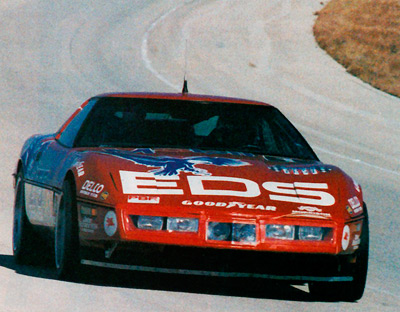
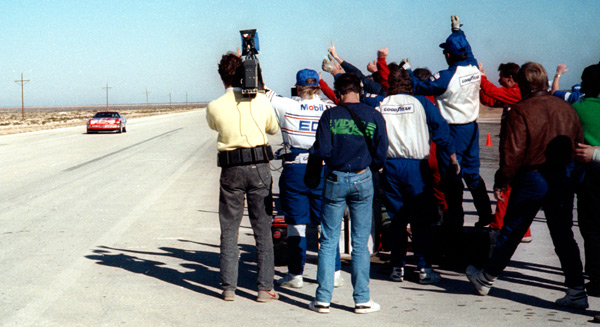
“To me," Morrison said after getting out of the car, "this was a very sacred thing we set out to do–break a record that‘s 50 years old. It was very difficult to achieve, but I’ve owned Corvettes since 1962 and there’s nothing I wanted to do more than break this record.”
The ZR-1 continued with the 5000-mile in reach but, incredibly, with eight laps to go, there was a problem–a coolant leak from a hose chaffed by the fan shroud. The car came in with the water temperature pegged. The crew replaced the hose and added coolant. Stu Hayner, the final driver, was told to run the last laps at 140 mph. The ZR-1 passed 5000 miles at 28-hours, 46-minutes and 12.426 seconds after the start.
The score? Three outright World Records: 5000-kilometers at 175.710 mph, 24-hours at 175.885 and 5000-miles at 173.791, plus four other FIA International marks in class A-G2-C10. Immediately after the event, the drivers and crew signed the underside of the hood. The WRR ZR-1 went on a promotional tour and then was donated to the National Corvette Museum where it remains, today.
 "It didn't seem much of a deal until after I did it," Heinricy reflected. "I thought: This is a World's speed record–three speed records! And two of them stood for 50 years. Pretty incredible. What made me feel even better was that the car was so stock.
"It didn't seem much of a deal until after I did it," Heinricy reflected. "I thought: This is a World's speed record–three speed records! And two of them stood for 50 years. Pretty incredible. What made me feel even better was that the car was so stock.
A Future WRR?
"Doing another Record Run comes up every now and then," John continued. "People say about the new ZR1, 'You ought reset that record' and I think, 'Do you have any idea what you're talkin' about? (laughs). Wow, here's another person without the foggiest idea what it's takes to do that.
"Boy, you'd have to go pretty damn fast. The record is now 200 (ed: set in 2002 by a carbon-fiber-bodied, V12-powered, Volkswagen prototype) so you'd have to average near 210. Not that the car couldn't do it, but it'd be a very tough engine test (ed: maybe an even tougher logistics and cost challenge.) And not at Fort Stockton. I'd consider some place safer, like Nardo (Italy) or something like that."
"I would do it again," Scott Allman agreed. "I would be smarter though. We managed the risk at Ft. Stockton and we could manage the risk, again, but I am sure we would do it differently. Would some place else be safer? Possibly. There is a good chance, however, the risk would similar–but the issues might be different. I would be willing to tackle it."
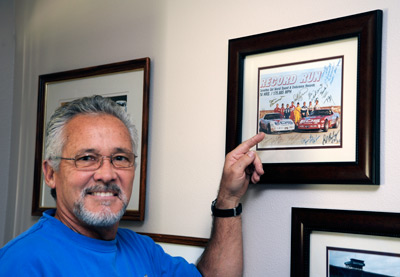 "Twenty years next March–isn't that amazing?" Stu Hayner reflected. "After we set the Records, I remember how quiet it was. It wasn't just being tired. I was really glad it was over and nobody got hurt. The stress level was huge. Every lap I said a prayer because it was so dangerous. I remember looking at Tommy Roe–the look on his face–he was so glad the car made it, nobody got hurt and we set the Records. Doing it again? I don't know how they could beat that record and be safe. I'm not saying it couldn't be done, but there would be a lot of things you'd have to do to make it safer."
"Twenty years next March–isn't that amazing?" Stu Hayner reflected. "After we set the Records, I remember how quiet it was. It wasn't just being tired. I was really glad it was over and nobody got hurt. The stress level was huge. Every lap I said a prayer because it was so dangerous. I remember looking at Tommy Roe–the look on his face–he was so glad the car made it, nobody got hurt and we set the Records. Doing it again? I don't know how they could beat that record and be safe. I'm not saying it couldn't be done, but there would be a lot of things you'd have to do to make it safer."
"For a long time, I said 'That's one of the craziest things I've ever done and somebody else could do it again,'" Jim Minneker told us. "Lately, I've changed my mind, given a safer facility with barriers such as what (NASCAR) Sprint Cup tracks have. If we had that, I'd feel pretty good about doing it, so if the phone rang; I'd pick it up."
Hib Halverson is a long-time member of the ZR-1 Net Registry, owns '95 #140 and was the only media member present at the World Record Run in 1990. He has written about the WRR for Road&Track, Vette Magazine and Corvette Enthusaist magazine.
This article was previously published in the April 2010 issue of Corvette Enthusiast. The ZR-1 Net Registry web site appreciates CE's Editor, Andy Bolig, giving us permission to reprint the story.